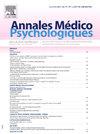Cognitive and Computational Accounts of Delusions: Problems and Progress
IF 0.5
4区 医学
Q4 PSYCHIATRY
引用次数: 0
Abstract
We discuss the evolution of a computational model of delusions, beginning with a background consideration of how computational psychiatry, with its roots firmly based in cognitive neuropsychiatry, seeks to develop descriptive and mechanistic models that reach across different levels of explanation in order to provide more comprehensive understanding of how neurobiological, cognitive, subjective and sociocultural factors may all contribute to complex psychopathology. This quest for bridging explanations – or “consilience” – across the levels is a shared goal of computational psychiatry and cognitive neuropsychiatry and is, we argue, crucial to explaining delusional beliefs. We outline how early computational models appealed to prediction error disturbances as a basis for understanding the early emergence of delusions and show that, despite empirical support, there have been certain explanatory limitations that make a simple prediction error account partially limited. Embedding the account within the increasingly influential hierarchical predictive processing framework subsequently offered a more powerful and comprehensive account, particularly by encouraging the consideration hierarchically-organized inference and its evolution over time. However, further limitations remain in its explanatory scope, most notably the fact that delusions can emerge rapidly and suddenly in a way that seems revelatory and convincing. This phenomenon is not easily encompassed by the standard predictive processing account which emphasizes an iterative process of optimizing inference. However, more recent development in the form of “Hybrid Predictive Coding” posits a complementary rapid inference mechanism. We discuss how this hybrid approach may be key to a more comprehensive computational understanding of delusions.
妄想症的认知与计算论述:问题与进展
我们讨论了妄想症计算模型的演变,首先介绍了计算精神病学的背景,它以认知神经精神病学为坚实基础,寻求建立跨越不同解释层次的描述性和机制性模型,以便更全面地理解神经生物学、认知、主观和社会文化因素如何共同导致复杂的精神病理学。我们认为,计算精神病学和认知神经精神病学的共同目标是寻求跨越不同层次的解释(或称 "一致性"),这对于解释妄想信念至关重要。我们概述了早期的计算模型是如何将预测误差干扰作为理解妄想早期出现的基础的,并表明尽管有经验支持,但某些解释上的局限性使得简单的预测误差解释受到了部分限制。随后,将这一解释嵌入影响力日益增大的分层预测处理框架,特别是通过鼓励考虑分层组织的推理及其随时间的演变,提供了一个更强大、更全面的解释。然而,其解释范围仍存在进一步的局限性,最明显的是妄想会以一种看似启示性和令人信服的方式迅速而突然地出现。这种现象不容易被标准的预测处理解释所涵盖,因为标准的预测处理解释强调的是优化推理的迭代过程。然而,"混合预测编码 "的最新发展提出了一种互补的快速推理机制。我们将讨论这种混合方法如何成为通过计算更全面地理解妄想症的关键。
本文章由计算机程序翻译,如有差异,请以英文原文为准。
求助全文
约1分钟内获得全文
求助全文
来源期刊

Annales medico-psychologiques
医学-精神病学
CiteScore
1.30
自引率
33.30%
发文量
196
审稿时长
4-8 weeks
期刊介绍:
The Annales Médico-Psychologiques is a peer-reviewed medical journal covering the field of psychiatry. Articles are published in French or in English. The journal was established in 1843 and is published by Elsevier on behalf of the Société Médico-Psychologique.
The journal publishes 10 times a year original articles covering biological, genetic, psychological, forensic and cultural issues relevant to the diagnosis and treatment of mental illness, as well as peer reviewed articles that have been presented and discussed during meetings of the Société Médico-Psychologique.To report on the major currents of thought of contemporary psychiatry, and to publish clinical and biological research of international standard, these are the aims of the Annales Médico-Psychologiques.
 求助内容:
求助内容: 应助结果提醒方式:
应助结果提醒方式:


